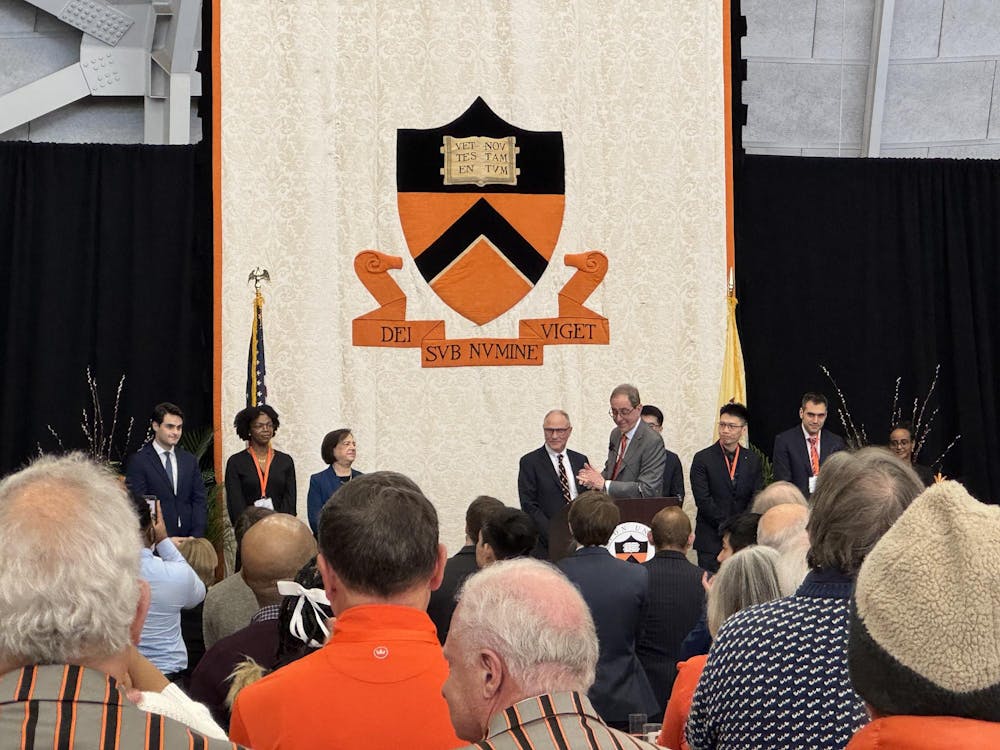Students, faculty, and families came together with alumni, including Supreme Court associate justice Elena Kagan ’81 and Nobel Memorial Prize winner David Card GS ’83 to celebrate Alumni Day on Feb. 22. Alumni Day 2025 had the highest attendance in history, President Christopher Eisgruber ’83 said in a speech during the day’s luncheon.
The schedule of events included the presentation of student and alumni awards, a luncheon sharing updates on the University, the Service of Remembrance for alumni who have passed in the last year, and receptions hosted by various groups, as well as shows, exhibits, and sports events.
The day began at 9:15 a.m. with the presentation of awards in Richardson Auditorium, where approximately 900 people attended. More than 100 people watched a livestream from an overflow room in McCosh 50.
“It was huge,” Christine Robinson, a spouse of a ’72 graduate and parent of an ’07 graduate said. “It sort of felt like Madison Square Garden trying to get into Richardson.”
Kagan received the Woodrow Wilson Award, which is annually conferred to alumni who exemplify the phrase “Princeton in the nation’s service.” In a conversation with Eisgruber, Kagan focused on her college experience, including her work on The Daily Princetonian, and her time in the Supreme Court.
Graduate Students Pietro Cibinel, Rama Hagos, Tung Nguyen, and Zhiyi “Allen” Ren were awarded Porter Ogden Jacobus fellowships, while current undergraduate students Avi Attar ’25 and Jennifer Nwokeji ’25 received the Pyne Prize for outstanding academic and extracurricular service.
Card, Professor Emeritus of Economics at the University of California, Berkeley, was the recipient of the James Madison Medal and gave a lecture to the crowd entitled “The Princeton School of Labor Economics.”
“A great institution with great support and the right people can make a big difference,” Card said. “That can be true even in economics when progress is slow.”
Outside Jadwin Gymnasium, where the reception and luncheon was held, four members of Sunrise Princeton passed out flyers asking alumni to support their divestment campaign against BP. When asked about why Sunrise chose to engage with alumni, Zach Goldberg ’28 explained that it was “because of donations. They have been really effective in forcing the university to care about these issues.”
The reception began at Jadwin Gymnasium at 11:30 a.m. Hundreds of alumni, spouses, faculty members, and students crowded into the reception, which began with canapés and then moved to a seated meal.
“Back then, they didn’t do all the awards here, so there were many fewer students who attended,” said Macie Green Van Rensselaer ’73, a member of Princeton’s first class to include women. Van Rensselaer first attended Alumni Day as a student who worked for the Alumni Council.
“I’ve been involved in Alumni Day for a long, long time, and I love coming back, and I always enjoy the talks. It’s great to see both the undergrad awards and the graduate student awards, to affirm my belief this is the best day,” Van Rensselaer said.

“Being a Princeton student is really, really challenging and rewarding. Being an alum is all about having a rewarding experience. Being married to an alum is the best of all scenarios,” said Stephen Kim, Associate Director for Communication and Information for the Princeton University Art Museum (PUAM) and spouse of Julie Kim ’92.
“I didn’t have to do the challenging part: I get to draw the benefits of the amazing community and all the things, like Alumni Day, that the University does for this community,” Kim continued.
The luncheon began with a speech by Monica Moore Thompson ’89, who summarized the activities of the Alumni Association.
“It’s a pleasure to lead the most engaging, passionate, noisy, and connected alumni network in the world.” Thompson said. “I am Princeton, you are Princeton, and together we are Princeton.”
The luncheon also included a speech from Eisgruber, who emphasized the importance of “being open to change.”
“You can see, just by looking at the campus today, that Princeton is very much under construction,” Eisgruber said. Eisgruber highlighted the increasing percentage of students that are eligible for financial aid and Pell Grants, the reinstatement of the transfer program in 2018, and the University’s partnerships with different organizations and institutions, like the New Jersey AI Hub.
“I am proud of this university. I am proud that we are always under construction, looking to the future, open to new perspectives, even when they challenge the status quo, and unafraid to take the risks and make audacious bets on people and ideas from generation to generation,” he said.
Director of PUAM James Steward ’76 gave a presentation about the new museum, including a slideshow of new interior photographs and renderings. PUAM is set to open in October.
He detailed various artifacts that will be seen in the museum, including a 15th century Spanish staircase, a sculpture by Gian Lorenzo Bernini, and a portrait of George Washington by Charles Willson Peale from just after the American revolution.
“My invitation to all of you is to come back in the fall to discover this new museum,” Steward concluded. “[It’s] really going to put us on the map in a different way as a place in which the arts and communities thrive.”
The annual Service of Remembrance, which commemorates alumni and faculty members who have passed away in the past year, took place at 3 p.m. in the University Chapel. The service included a memorial procession, in which representatives from every undergraduate and alumni class, the Graduate School, and faculty and staff each carry a symbolic white carnation to place inside the Memorial Wreath. Christian, Jewish, and Hindu prayers were spoken during the occasion.
“I was incredibly impressed by how diverse [the service] was,” Namrita Kapur ’89 told the ‘Prince.’ “I found a place for me in it, and I didn't necessarily feel that way when I was a student here. And so that feels like a really valuable evolution in the culture here.”
Approximately half a dozen pro-Palestine protesters demonstrated outside the chapel as alumni filed in by reading out the names of Palestinian children that had been killed in Gaza.
Following the service, a closing reception was held in the Chancellor Green rotunda, as many gathered in the library space to raise a glass to the 75th anniversary of the Association of Princeton Graduate Alumni (APGA). Laurence Latimer GS ’01, President of the APGA, toasted to the event.
“This is the most Princeton of events, where we get together to celebrate the best of our peers and their amazing accomplishments in academics, industry, and government service,” Latimer said. “It’s the people that make this place special.”
Multiple other events occurred alongside the main proceedings. These included “Reaching Across Generations,” a panel sponsored by the Associations of Black Princeton Alumni (ABPA), the Black Student Union (BSU), and Office of the Dean of Undergraduate Students (ODUS), as well as “In the Work: Securing Equity for LGBTQ+ Youth and Students in Disruptive Times,” a Queer Princeton Alumni (QPA) panel and reception.
“[Alumni Day] really gives you the opportunity to connect beyond your class,” said Elizabeth Sikorovsky ’89. “It’s a spark of warmth in the cold time.”
Ed Strauss ’72 added, “It’s a one-day intensive crash course in why this place is so magnificent and world famous and is always at the top of the list in any of the surveys.”
Nikki Han is an assistant News editor and a contributing Features writer. She runs the Faculty, Graduate Students, and Alumni coverage area.
Luke Grippo is a staff News writer for the ‘Prince.’ He is from South Jersey and usually covers administrative issues, including USG, the CPUC, and institutional legacy.
Please send any corrections to corrections[at]dailyprincetonian.com.








